Observe the circuit given in Fig. 14.8.
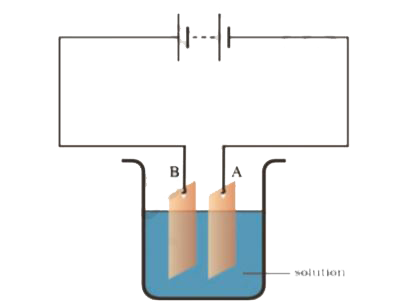
Boojho set up this circuit for purification of copper. What will be the nature of – (i) plate A (ii) plate B (iii) the solution.
Explain the process of purification.
(i) plate A – Pure copper (ii) plate B –Impure copper (iii) the solution –Copper sulphate Copper from impure copper plate is transferred to the pure copper plate by the process of electroplating.
Topper's Solved these Questions
Similar Questions
Observe the following circuit given in Fig. 14.9.

Current does not flow in the circuit if there is a gap between the two wires. Does it indicate that air is a poor conductor of electricity? Does air never conduct electricity? Explain.
View SolutionObserving that the bulb does not glow in the circuit shown in Fig. 14.11 A, Boojho changed the circuit as shown in Fig 14.11 B. He observed deflection in the magnetic compass.
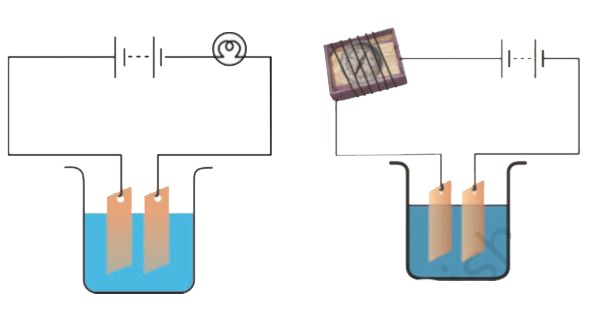
(i) What does the deflection in magnetic compass indicate?
(ii) Why did the bulb not glow in Fig.14.11 A?
(iii) What would be the effect of increase in the number of turns in the coil wound around the magnetic compass in Fig. 14.11B?
(iv) What will be observed if the number of cells are increased in the circuit shown in Fig. 14.11B?
View SolutionIn the circuit given as Fig. 14.7, Boojho observed that copper is deposited on the electrode connected to the negative terminal of the battery. Paheli tried to repeat the same experiment. But she could find only one copper plate. Therefore she took a carbon rod as negative electrode. Will copper be still deposited on the carbon rod? Explain your answer.
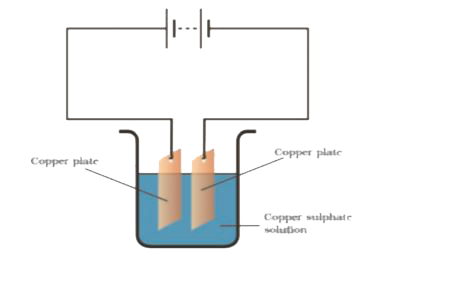
View SolutionPaheli took a wire of length 10 cm. Boojho took a wire of 5 cm of the same material and thickness. Both of them connected the wires as shown in the circuit given in Figure 14.4. The current flowing in both the circuits is the same.
(i) Will the heat produced in both the cases be equal? Explain.
(ii) Will the heat produced be the same if the wires taken by them are of equal lengths but of different thickness? Explain.

View SolutionThe diagram shows the process of purification of copper metal. A thick copper plate A of impure copper and a thin copper plate B are immersed in a metal sulphate solution and an electric current is passed through it.
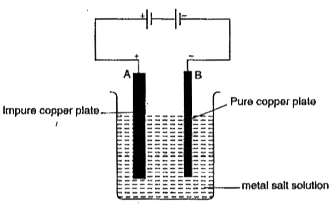
What is liberated at the cathode? Explain.
View SolutionBoojho made the circuit given in Fig. 14.3 and observed that the bulb did not glow. On Paheli’s suggestion he added one more cell in the circuit. The bulb now glows. Explain.

View SolutionAn LC circuit oscillating at natural frequency conssts of an inductor of inductance 30 m H and a capacitor of capacitance 60μF. The maximum value of instantaneous charge on capacitor in the circuit is 200 μC . If I is the current in the circuit then answer the following :
(i) What is the value of dIdt when charge is 150 μC?
(ii) Calculate the value of I when charge is 200 μC .
(iii) Find the maximum value of I.
(iv) For what value of q I is half of its maximum value ?
View SolutionA capacitor of capacitance C, which is initially charged up to a potential difference ε, is connected with a battery of emf ε/2 such that the positive terminal of the battery is connected with the positive plate of the capacitor. After a long time.
i. find the total charge flow through the battery
ii. find the total work done by the battery
iii. Find the heat dissipated in the circuit during the process of charging.
View SolutionTbe diagram shows the process of purification of copper metal A thick copper p]ate A of impure copper and a thin copper plate B are immersed in a metal ·sulphate solution and an. electric current is passed through it.
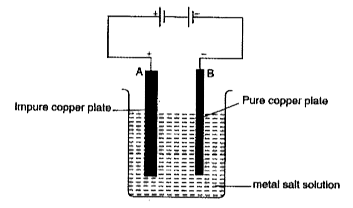
Which metal solution is taken as electrolyte?
View SolutionTbe diagram shows the process of purification of copper metal A thick copper p]ate A of impure copper and a thin copper plate B are immersed in a metal ·sulphate solution and an. electric current is passed through it.
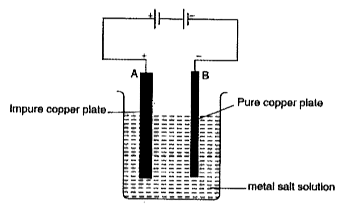
Does the copper anode (increase/decrease/ remains unchanged) in weight?
View Solution
